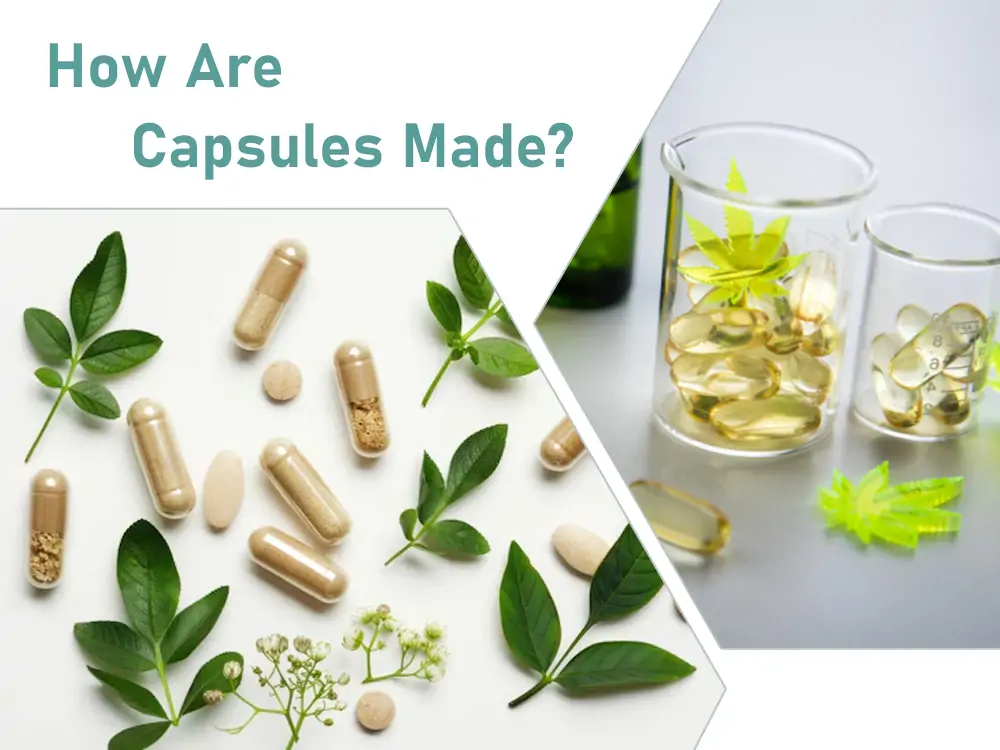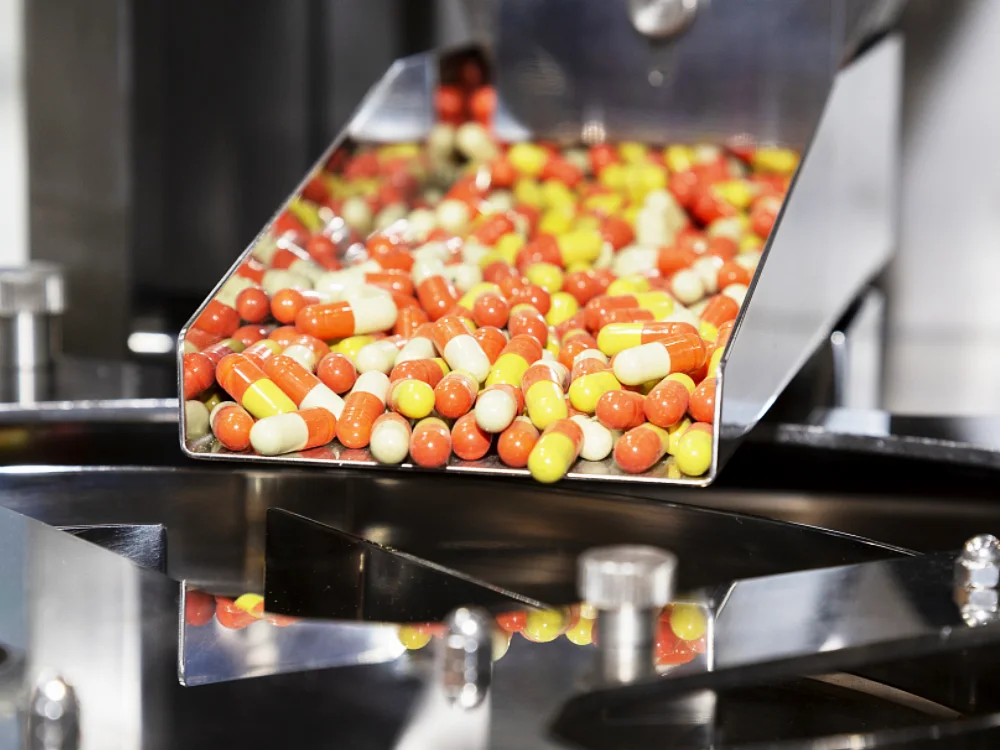
Nutritional supplements come in various forms, with capsules being one of the most widely used globally due to their versatility and consumer appeal. As the supplement industry evolves, new formats like powders and softgels are reshaping the market. To explore these changing trends, check out Pills, Powders, and Purpose: The Changing Face of Supplements. These two parts associate together, thus resulting in a closed casing.
You can see that consumers admire capsules for:
- swallowing ease
- masking of displeasing tastes
- precise dosing capability
They can comprise powders, liquids, and even small pellets, making them versatile for various active supplement ingredients.
Here, we’ll examine the capsule manufacturing procedure in detail and examine the differing capsule types and their raw materials.
Lastly, we’ll answer some often-inquired queries about this renowned supplement form.
Different types of capsules and raw materials
There are differing capsule types, with the prominent ones being gelatin and HPMC capsules. Let’s look at these two in brief:
1. Gelatin Capsules
Gelatin capsules are one of the oldest capsule forms used currently. They are fabricated from collagen derived from bovine or pork sources.
Bovine hide is regarded as one of the ideal choices. It permits the capsules to be Halal and Kosher-certified and meet a varied consumer range.
Gelatin capsules are favored for their low moisture content and prolonged shelf life. They also protect active ingredients.
2. HPMC Capsules
Hydroxypropyl methylcellulose (HPMC) capsules are fabricated from 100% plant-based materials. They are a vegan- and vegetarian-friendly substitute for gelatin capsules.
These capsules suit a broad range of consumers, especially those with cultural, dietary, or religious restrictions. They are also Halal and Kosher-certified.
HMPC capsules especially suit moisture-sensitive products and low-relative humidity uses.
Raw Materials for Capsule Manufacturing Process
With that, let’s look at the vital raw materials for the capsule manufacturing process:
- Gelatin or HPMC: Manufacturers chiefly make capsules from gelatin, the primary ingredient derived from the hydrolysis of animal collagen. For HPMC capsules, the primary ingredient is HPMC, which originates from plant cellulose. It’s a semi-synthetic, biocompatible, and inert cellulose polymer.
- Purified water: It’s employed to dissolve and moisten the gelatin. That makes certain it forms a consistent jelly-like mass. For HPMC capsules, it’s used to dissolve the HPMC and form the capsule shell.
- Plasticizers: These aid the capsules to become durable and flexible.
- Colorants: Their addition gives the capsules distinctive colors and appearance.
- Preservatives: Their addition extends the capsules’ shelf life and avoids microbial contamination.
The selection of such raw materials is done with great care. Subsequently, these are processed to meet the standards, further ensuring the capsules’ safety and effectiveness.
Capsule Manufacturing Process
The capsule manufacturing process is imperative for companies that manufacture supplements and medications. Manufacturers should follow each step meticulously to achieve the desired outcomes.
The following is the procedure for capsule manufacturing:
Step 1: Raw Material Melting and Coloring Materials
The capsule manufacturing process commences with the melting and coloring of raw materials.
Making gelatin capsules involves heating up hard gelatin in a melting tank. It’s done till it outcomes in a homogenous solution. Next, distilled water is added to make an even viscous liquid.
The solution is then heated at a fixed temperature until it dissolves entirely. It’s done while ensuring the gelatin’s properties don’t degrade. Afterward, ingredients like colorants and preservatives are added when the gelatin melts. Colorants aim to get the desirable color.
In HPMC capsules, HPMC is dissolved in water to form a gel-like mixture. During this step, ingredients like colorants and preservatives are added.
You can see that this step acts as the foundation for other succeeding steps.
Step 2: Capsule Molding and Drying
The next step in the fabrication process is capsule molding and drying.
The stainless-steel molding pins are dipped into the gel-like mixture to form the capsule shells. The coated pins are rotated to get a consistent coating and to wipe out extra substances. This ensures the homogeneity of the capsules’ thickness and size.
The molded capsules are then dried under regulated conditions. For this, humidity and temperature are kept consistent. This ascertains constant drying and uniform hardening of all capsules.
Step 3: Capsule Cutting
After the drying and hardening process, capsule shells are formed. These are cut and trimmed to their finishing dimensions via a pin plate. Precise cutting tools are employed here to get clean and consistent edges.
Proper trimming is imperative for the next steps, such as the filling and sealing. Otherwise, shape and size variations can result in issues in the filling process. That can significantly affect the effectiveness and quality of the fabricated capsules.
Step 4: Filling and Sealing the Capsules
Next, the empty capsule bodies are filled with the product, e.g., liquids, powders, or granules. It’s accomplished via capsule-filling machines. These are available in three principal varieties:
- Manual
- Semi-automatic
- Fully Automatic
Accurate filling ensures that each capsule contains the precise dosage. This process of filling the capsules is better known as encapsulation.
Next, the capsule’s cap is placed on the body. It’s then sealed to prevent leaks. Capsules can then be polished to bring about a smooth finish.
Step 5: Capsule Quality Inspection, Printing, And Packaging
The last stage in capsule supplement fabrication involves quality inspection, printing, and packaging.
Capsules undergo stringent checks to fulfill the desired appearance, weight, and safety standards. Primarily, they are checked for the following:
- Bubbles
- Abnormal shapes
- Dark spots
- Irregularities, inclusive of black spots
For this purpose, image-processing technology and specialized capsule inspection machines are often employed. Thus, this quality assurance is vital to ensure the finished capsules’ safety and efficacy.
Afterward, printing on colored capsules is carried out. The aim is to aid with product identification and branding.
You can see that specialized printing machines perform this process. They print information on the capsule that can include:
- The supplement name
- Dosage
- Manufacturer detail
This process helps to distinguish between differing supplements. It also assures they fulfill labeling guidelines. Accurate printing ensures the consumer receives the correct supplement and their quantities.
That process employs edible inks. They stick to the capsule’s surface and don’t interfere with the quality of inside content.
After printing, the capsules are counted. They are then packed into fitting containers, such as blister packs or bottles.
The packaging aims to protect the capsules from environmental conditions. These can include light and moisture that may degrade the quality of the supplement. It also provides crucial details like the batch numbers and expiry dates.
How Does Handian Make Capsules?

You may know that Handian Nutrition is a leading manufacturer of capsule supplements globally. Located in China, we specialize in private-label and custom capsule supplement manufacturing.
We welcome you to watch out for our capsule services at Handian. As a capsule contract manufacturer, some of our prominent custom capsule options include:
- Gelatin, Vegan/Vegetarian, Organic, Halal and Kosher
- Differing capsule sizes inclusive of 2, 1, 0, 00, and others
- Colors and design to match the brand identity
- Packaging and design of labels to meet the brand image
- Free to choose stock formula types, e.g., maca capsules and green tea ingredient capsules
Moreover, Handian fabricates more than 3.3 million capsules every day. Some vital steps of our capsule supplement fabrication process include:
- Preparation of Raw Materials
- Mixing and Processing of Capsule Contents
- Capsule Filling and Sealing
- Packaging and Quality Inspection
All our products undergo stringent testing. We possess various certifications that assure quality and the highest standards. Some of these are:
- GMP (Good Manufacturing Practice) Certification
- ISO 22000 Certification
- FDA (Food and Drug Administration) Certification
- FSSC22000 (Food Safety System Certification)
All these certifications showcase our commitment to quality and safety. We possess a reliable, automated capsule production line.
We can also manage complex formulations and use the most cutting-edge production technology. Our quality control staff supervises the capsule fabrication at each stage. Our top priority is fulfilling your customer requirements.
Frequently Asked Questions
How do capsules dissolve in the body?
Gelatin capsules are digested easily and dissolve in minutes when reaching the stomach. That ensures the supplement inside is easily absorbed rather than passing through the digestive system unused. In contrast, HPMC capsules dissolve slower in the stomach. That’s because they are more resistant to stomach acid.
Both capsule types dissolve via interaction with body fluids and digestive enzymes. That permits the body to absorb the active ingredients.
What is the difference between plant-based capsules and traditional gelatin capsules?
Plant-based capsules and conventional gelatin capsules differ from each other in several ways. The former typically have HPMC as the main ingredient of the capsule shell. The latter comprises gelatin derived from collagen that’s extracted from animal sources.
Plant-based capsules are apt for people with dietary or religious restrictions. They are also suitable for vegans or those following vegetarian diets. Gelatin capsules are the most common capsule types used for supplements and medications.
Plant-based capsules have lower moisture content and greater stability in differing humidity levels and temperatures, especially compared to gelatin capsules.
How do I choose the right capsule supplement?
Consider the following to aid you in selecting the fitting capsule supplement:
- Look at your distinct requirements and health goals. For example, a multivitamin capsule supplement can be worthwhile for general health.
- Examine whether the ingredients are suitable for you. Further, check for any potential interactions with other medicines and supplements.
- Please check the capsule size to see if it’s suitable for you. It should be easy to swallow.
- Look at the dosage of the active ingredient in each capsule. See if it’s fitting for you.
- Find out if the capsule supplement is from a reputable and recognized brand. It should have quality labels and certificates.
- Reflect on whether the capsule supplement aligns with your nutritional preferences.
What are the manufacturing defects of capsules?
Defects can occur in any manufacturing process. The following are some common ones in capsule manufacturing:
- Deviation of color: The color of the final capsule is different than expected.
- Holes or scratch: The capsule may have holes or scratches.
- Short body or cap: During the cutting step, the body or cap of capsules may be small.
- Long body or cap: There can be an elevated size of the body or cap of the capsule.
- Double cap: The capsule body can have two caps in this defect.
- Flawed printing: Sometimes, the capsule’s printing is flawed. However, printing is imperative for identifying and distinguishing products.
Why are the sizes for capsules?
Capsules have standard sizes that are designated by numerical values. They are numbered precisely: 000, 00, 0, 1, 2, 3, 4, and 5.
These numbers remain the same for all types of HPMC and gelatin capsules. Most capsule-filling machines are fabricated to fit with these standard sizes.
Conclusion
The capsule manufacturing process is undeniably complicated and intricate. Each step is executed deliberately to ensure the highest quality, efficacy, and safety.
Summing up, the primary stages in the capsule supplement manufacturing include:
- Raw Material Melting and Coloring Materials
- Capsule Molding and Drying
- Capsule Cutting
- Filling and Sealing the Capsules
- Capsule Quality Inspection, Printing, And Packaging
You can comprehend that every move in this procedure influences the fabrication. Maintaining hygienic conditions is also pivotal for the entire production process. It’s imperative for capsule manufacturers globally.
It’s hoped you have grasped the entire capsule production process by now.
